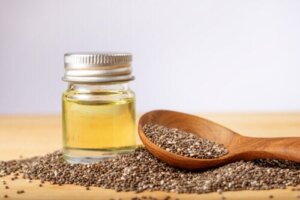10 Benefits of Chia with Scientific Evidence


Reviewed and approved by the nutritionist Maria Patricia Pinero Corredor
The benefits of chia have been researched for several decades. These seeds, obtained from the Salvia hispanica plant, have been cultivated since 3500 B.C. in countries such as Mexico and Guatemala. According to historical accounts, they were offered to the Aztec gods in religious ceremonies. In addition, due to their nutritional quality, it was one of the staple foods in both the Aztec and Mayan cultures.
Despite this, it wasn’t until the 1980s that their consumption began to spread to other parts of the world. In the United States -particularly- they gained popularity when they were promoted as a ‘superfood’ or a ‘functional food’; that is, a food that could offer additional health benefits.
And although these labels are a marketing strategy, the truth is that science has been able to corroborate that their inclusion in a healthy and balanced diet is indeed positive for several body functions. Do you want to know more about it? Let’s see what the scientific evidence says about this food.
Nutritional information about chia seeds
The small seeds of the Salvia hispanica plant can be black or white. They’re now widely cultivated in countries such as Mexico, Guatemala, Peru, Argentina, Australia, and the United States. They’re valued mainly for their content of healthy fats, such as omega-3.
However, they provide more than that. A publication by the United States Department of Agriculture (USDA) states that every 28 grams (1 oz) of dry chia seeds provide the following:
- Calories: 138
- Fat: 8.7 grams
- Sodium: 5 milligrams
- Carbohydrates: 12 grams
- Protein: 4.7 grams
- Sugars: 0 grams
- Fiber: 9.8 grams
On the other hand, a study published in the Molecules magazine details that these seeds are a considerable source of polyunsaturated fatty acids, dietary fiber, polyphenols and antioxidants (such as caffeic acid, rosmarinic acid, myricetin, quercetin, and others). It also provides vitamins (A, B, K, E, and D).
It’s precisely because of this composition that the food has been the subject of numerous studies. It has been determined to have anti-inflammatory, antimicrobial, antidiabetic, immunomodulatory, and antitumor potential, among others.
Benefits of chia seeds supported by evidence
Chia has been used for food and medicinal purposes. A review shared through Journal of Food Science and Technology highlights that it’s a food with nutraceutical and pharmaceutical potential.
In addition, it provides the 9 essential amino acids that the body cannot produce and is gluten-free. What are its other benefits?
1. Digestive health
There are several benefits of chia for digestive health. A study shared through Food Science & Nutrition highlights that, due to its content in insoluble dietary fiber, this food can help relieve constipation. In particular, it improves peristaltic movement, increases the number of bowel movements, and prevents intestinal obstruction.
On the other hand, this same source highlights that its content of unsaturated fatty acids, gluten-free proteins, minerals, and phenolic compounds are beneficial for the prevention of gastrointestinal diseases, such as colon cancer.
While not a first-choice treatment or anything like it, its consumption complements the diet to maintain good digestion, reduce inflammation levels, balance the microbiota, and inhibit the negative effects of free radicals.
It should be noted that consumption should be in moderation. The American organization WebMD points out that eating too many chia seeds can lead to constipation, diarrhea, bloating and gas due to excess fiber. It can even trigger outbreaks in patients with Crohn’s disease.

2. Healthy weight
First of all, it should be clarified that chia seeds are not a ‘superfood’ for weight loss. Until a few years ago, their consumption was promoted as an almost ‘magical’ formula for weight loss. However, nutrition professionals have made several clarifications around this issue.
The most important one is that it doesn’t have ‘super properties’ to stimulate our metabolism or promote fat burning. Its inclusion in the regular diet is only a healthy supplement for those seeking to maintain a healthy and stable weight.
Its benefits are largely attributed to its content of dietary fiber and protein. Both nutrients help to prolong the feeling of satiety, which helps to prevent high calorie intake. A review shared by the journal Molecules cites a study that supports these properties.
In the research, patients who were supplemented with 30 grams of chia seeds over a 6-month period obtained a greater weight loss (1.9 kilograms) than those who took a wheat bran supplement (0.3 kilograms). In addition, changes in waist circumference, body composition, blood sugar control, and satiety hormones were observed.
Meanwhile, through Nutrition Research and Practice, researchers reported that eating chia seeds as a mid-morning snack can induce short-term satiety in healthy people.
3. Bone health
Chia has essential minerals that provide benefits to bones. To be more precise, it contains calcium, phosphorus and magnesium, which are key to bone, muscle and nerve strengthening.
In an animal study reported in the Journal of the American College of Nutrition, chia seeds helped maintain bone health after being offered as a 20% source of calcium in a diet that met 100% of the mineral recommendation.
The long-chain omega-3 polyunsaturated fatty acids contained in these seeds are also believed to play an important role in bone health. Observational studies have found their consumption to be associated with increased bone mineral density.
However, evidence for these effects is limited. Further research in humans is needed to corroborate the results.
4, Blood sugar levels
Due to their content of dietary fiber and omega-3 fatty acids, chia seeds are a health food for people with prediabetes and diabetes. These nutrients play a positive role in reducing insulin resistance and stabilizing blood glucose levels.
A study shared in the journal Nutrients corroborated the hypoglycemic properties of this food. In this, people who consumed bread fortified with chia seeds had lower postprandial (after ingestion) blood glucose levels compared to those who ate traditional bread.
5. Cardiovascular health
The polyunsaturated fatty acids, protein, and antioxidants in chia seeds work together to protect cardiovascular health. Research shared in the journal Foods determined that the omega-3 and omega-6 fatty acid composition of chia helps inhibit lipid accumulation and improves fatty acid oxidation. In addition, it decreases inflammatory status and the risk of cardiovascular disease.
Meanwhile, a study in Nutrition and Health reported that supplementation with chia seeds helped reduce systolic blood pressure levels in patients with diabetes. This suggests that they also help prevent hypertension.

6. Immune system
As a significant source of omega-3s, chia stands out as an ally of the immune system. A study shared in the International Journal of Molecular Sciences details that this family of polyunsaturated fatty acids stimulates the activation of cells of the innate and adaptive immune system.
So, its consumption helps the body to get rid of pathogens and damaged cells. Meanwhile, another study shared in the journal Foods suggests that chia protein hydrolysates (CPH) have the potential to strengthen immune functions and prevent diseases associated with inflammation and oxidation.
7. Cognitive health
Incorporating chia seeds into the regular diet may contribute to brain health care. According to a review revealed in the Journal of Nutrition & Food Sciences, omega-3 (which is abundant in this food) supports mental health and helps in the prevention of neuronal diseases, such as Alzheimer’s.
In itself, it plays a relevant role in nervous system activity, cognitive development, memory-related learning, and the development of brain synapses. Researchers suggest that dietary intake of Salvia hispanica L has a positive impact on memory abilities.
8. Antitumor potential
Chia’s antitumor benefits are attributed to its abundant content of kaempferol, quercetin, dietary fiber, and healthy fats. It isn’t a cure for cancer, nor is it a miracle food for cancer prevention. Still, its inclusion in the diet offers protection against the negative effects of free radicals.
As detailed in a publication in the journal Antioxidants, free radicals are reactive oxygen species (ROS) that can damage DNA and cause cell mutations that lead to the development of cancer.
9. Joint health
One of the nutritional strategies that benefit patients with joint diseases is the inclusion of chia in their daily diet. As a major source of alpha-linoleic acid (ALA), a type of anti-inflammatory omega-3 fatty acid, its consumption is associated with decreased pain and inflammation.
In a study shared by the Mediterranean Journal of Rheumatology, researchers reported that omega-3 fatty acids limit or modulate the inflammatory response. They suggest that they play a positive role in regulating the activity of rheumatoid arthritis and promoting its control.
10. Healthy skin
The nutritional composition of chia provides interesting benefits in the prevention of premature skin aging. A publication in Phytochemistry Reviews comments that these seeds are abundant in polyphenols derived from caffeic acid.
These compounds help protect the body against the negative action of free radicals and aging. In turn, other antioxidant compounds such as tocopherols, phytosterols, carotenoids, quercetin, and kaempferol exert positive effects in preventing cell deterioration.
Because of this, regular intake of these seeds and their derivatives is considered an adjuvant in the prevention of wrinkles, fine lines, blemishes, and other symptoms of skin aging.
Chia is also being investigated as a cosmetic agent. In a study shared by the Journal of Cosmetic Dermatology, a chia seed extract enriched with vitamin F helped clinically improve skin hydration and improve the skin barrier.
Vitamin F isn’t a vitamin as such. It’s a group of fatty acids, including linolenic acid (omega-3) and linoleic acid (omega-6).

Is there any risk in consuming chia seeds?
Most people can obtain the benefits of chia without experiencing side effects.
It’s considered a safe food, as long as it isn’t consumed in excess. The daily dose for adults varies between 13 and 15 grams (two tablespoons). For their part, children shouldn’t take more than 6 grams.
However, some reactions due to the excessive consumption of this food are the following:
- Gas
- Constipation
- Digestive discomfort
- Abdominal swelling
- High blood pressure (if taken simultaneously with antihypertensives)
Food allergies aren’t frequent, but they can happen. If so, some symptoms include vomiting, diarrhea, and itching of the tongue or mouth. Emergency care is necessary, as severe cases can cause anaphylaxis.
Ultimately, it’s important to remember to soak the seeds in water before consumption. When dry, they can get stuck in the throat and cause choking. When moistened, they take on a gelatinous texture that makes them easier to eat.
What to remember about chia and its benefits?
A wide variety of studies have documented the health benefits of chia. While more human research is needed, for now, the findings suggest that it’s a functional food, capable of protecting bone, digestive, cardiovascular, and brain health. In addition, it’s a good complement to maintain a healthy weight.
The most interesting thing is that it’s a versatile food that can be integrated in many ways into the diet. After soaking them in water for a minimum of 15 minutes, it’s possible to add them to smoothies, oatmeal, yogurt, and soups, among other things. What’s stopping you from trying them?!
All cited sources were thoroughly reviewed by our team to ensure their quality, reliability, currency, and validity. The bibliography of this article was considered reliable and of academic or scientific accuracy.
-
Alwosais, E. Z. M., Al-Ozairi, E., Zafar, T. A., & Alkandari, S. (2021). Chia seed (Salvia hispanica L.) supplementation to the diet of adults with type 2 diabetes improved systolic blood pressure: A randomized controlled trial. Nutrition and Health, 27(2), 181-189. https://journals.sagepub.com/doi/pdf/10.1177/0260106020981819
- Arthritis Foundation. (n.d.). Best Nuts and Seeds for Arthritis. Available in https://www.arthritis.org/health-wellness/healthy-living/nutrition/healthy-eating/best-nuts-and-seeds-for-arthritis
- Ayaz, A., Akyol, A., Inan-Eroglu, E., Cetin, A. K., Samur, G., & Akbiyik, F. (2017). Chia seed (Salvia Hispanica L.) added yogurt reduces short-term food intake and increases satiety: randomised controlled trial. Nutrition research and practice, 11(5), 412-418. https://synapse.koreamed.org/articles/1050906
- Carmen, A., & Alissa, S. (2019). Evaluación del efecto de la semilla de Salvia hispanica L.“chía” en el crecimiento de las cepas probióticas Lactobacillus casei ATCC 334 y Lactobacillus acidophilus ATCC 4356. https://alicia.concytec.gob.pe/vufind/Record/RPCH_0501d91c54649d04836d6118768b40a6
- FoodData Central. (2019) Seeds, chia seeds, dried. U.S. Department of Agriculture.
- Fusco, D., Colloca, G., Monaco, M. R. L., & Cesari, M. (2007). Effects of antioxidant supplementation on the aging process. Clinical interventions in aging, 2(3), 377-387. https://www.tandfonline.com/doi/abs/10.2147/cia.S12159918
-
Gutiérrez, S., Svahn, S. L., & Johansson, M. E. (2019). Effects of omega-3 fatty acids on immune cells. International journal of molecular sciences, 20(20), 5028. https://www.mdpi.com/550200
- Harvard T.H. Chan School of Public Health. Chia Seeds. (n.d.). Available in https://www.hsph.harvard.edu/nutritionsource/food-features/chia-seeds/
- Health Benefits of Chia Seeds. (2o22). WebMD. Available in https://www.webmd.com/diet/health-benefits-chia-seeds
-
Huber, K. L., Fernández, J. R., Webb, C., Rouzard, K., Healy, J., Tamura, M., … & Pérez, E. (2020). HYVIA™: A novel, topical chia seed extract that improves skin hydration. Journal of Cosmetic Dermatology, 19(9), 2386-2393. https://onlinelibrary.wiley.com/doi/abs/10.1111/jocd.13469
-
Imran, M., Salehi, B., Sharifi-Rad, J., Aslam Gondal, T., Saeed, F., Imran, A., … & Estevinho, L. M. (2019). Kaempferol: A key emphasis to its anticancer potential. Molecules, 24(12), 2277. https://www.mdpi.com/482226
- Knez Hrnčič, M., Ivanovski, M., Cör, D., & Knez, Ž. (2020). Chia Seeds (Salvia hispanica L.): an overview—phytochemical profile, isolation methods, and application. Molecules, 25(1), 11. https://www.mdpi.com/598938
-
Kostoglou-Athanassiou, I., Athanassiou, L., & Athanassiou, P. (2020). The effect of omega-3 fatty acids on rheumatoid arthritis. Mediterranean journal of rheumatology, 31(2), 190. https://www.ncbi.nlm.nih.gov/pmc/articles/PMC7362115/
- Kulczyński, B., Kobus-Cisowska, J., Taczanowski, M., Kmiecik, D., & Gramza-Michałowska, A. (2019). The chemical composition and nutritional value of chia seeds—Current state of knowledge. Nutrients, 11(6), 1242. https://www.mdpi.com/2072-6643/11/6/1242
- Lavado-García, J., Roncero-Martin, R., Moran, J. M., Pedrera-Canal, M., Aliaga, I., Leal-Hernandez, O., … & Canal-Macias, M. L. (2018). Long-chain omega-3 polyunsaturated fatty acid dietary intake is positively associated with bone mineral density in normal and osteopenic Spanish women. PloS one, 13(1), e0190539. https://journals.plos.org/plosone/article?id=10.1371/journal.pone.0190539
- Lee, K. J., Kim, K. S., Kim, H. N., Seo, J. A., & Song, S. W. (2014). Association between dietary calcium and phosphorus intakes, dietary calcium/phosphorus ratio and bone mass in the Korean population. Nutrition journal, 13, 1-8. https://link.springer.com/article/10.1186/1475-2891-13-114
-
Mishima, M. D. V., da Silva, B. P., Toledo, R. C. L., Costa, N. M. B., & Martino, H. S. D. (2021). Bioavailability of calcium from chia (Salvia hispanica L.) in ovariectomized rats fed a high fat diet. Journal of the American College of Nutrition, 40(5), 454-464. https://www.tandfonline.com/doi/abs/10.1080/07315724.2020.1790441
- Motyka, S., Koc, K., Ekiert, H., Blicharska, E., Czarnek, K., & Szopa, A. (2022). The current state of knowledge on Salvia hispanica and Salviae hispanicae semen (Chia Seeds). Molecules, 27(4), 1207. https://www.mdpi.com/1493422
- Onneken, P. (2018). Salvia hispanica L (Chia Seeds) as brain superfood: how seeds increase intelligence. J Nutr Food Sci, 8(684), 2. https://www.researchgate.net/profile/Peter-Onneken/publication/324702337_Salvia_hispanica_L_Chia_Seeds_as_Brain_Superfood_How_Seeds_Increase_Intelligence/links/60a3b811a6fdccb8dc639539/Salvia-hispanica-L-Chia-Seeds-as-Brain-Superfood-How-Seeds-Increase-Intelligence.pdf
-
Orchard, T. S., Larson, J. C., Alghothani, N., Bout-Tabaku, S., Cauley, J. A., Chen, Z., … & Jackson, R. D. (2014). Magnesium intake, bone mineral density, and fractures: results from the Women’s Health Initiative Observational Study. The American journal of clinical nutrition, 99(4), 926-933. https://academic.oup.com/ajcn/article-abstract/99/4/926/4637873
- Pandurangan, S. B., Al-Maiman, S. A., Al-Harbi, L. N., & Alshatwi, A. A. (2020). Beneficial fatty acid ratio of Salvia hispanica L.(Chia Seed) potentially inhibits adipocyte hypertrophy, and decreases adipokines expression and inflammation in macrophage. Foods, 9(3), 368. https://www.mdpi.com/670948
- Shonia, S., Kanga, R. S., & Ammu, K. R. (2019). Bioactive compounds: natural defense against cancer?. Biomolecules, 9(12). https://www.cabdirect.org/globalhealth/abstract/20203317755
- Villanueva-Lazo, A., Montserrat-de la Paz, S., Grao-Cruces, E., Pedroche, J., Toscano, R., Millan, F., & Millan-Linares, M. C. (2022). Antioxidant and Immunomodulatory Properties of Chia Protein Hydrolysates in Primary Human Monocyte–Macrophage Plasticity. Foods, 11(5), 623. https://www.mdpi.com/2304-8158/11/5/623
This text is provided for informational purposes only and does not replace consultation with a professional. If in doubt, consult your specialist.








